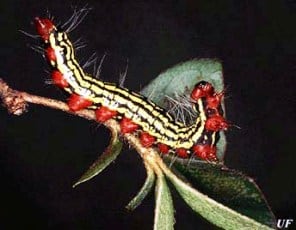
EDITOR’S NOTE: UF/IFAS County Extension Director for Nassau County and Horticulture Agent III, Rebecca Jordi addresses questions about landscaping and gardening in northeast Florida. She is also a University of Florida faculty member.___________
QUESTION: I have several plumbago shrubs in my yard but one of them is white. Do I have a mutation? PC
JORDI: Plumbago, Plumbago auriculata, is most commonly found with blue flowers however one of the specific cultivars of plumbago, ‘Alba’, produces white flowers.
Plumbago is a perfect plant for low growing hedges or a nice backdrop for smaller perennials or annuals. It can grow up to 5 feet tall with an equal spread. Flowering will occur best when planted in full sun although this shrub will tolerate some light shade. Plumbago requires little watering after it is established but it would need supplemental watering if your area experiences a drought. It has few disease or insect issues which make it a nice plant for people who are not full time residents. Some pruning might be required to keep it off driveways and sidewalks.
In Northeast Florida, it will die back during colder temperatures but return during the spring. This year, in the UF/IFAS Nassau County Demonstration garden, I have seen the plumbago full of adult butterflies which are drinking the nectar from the flowers. Because of its beauty and ability to attract wildlife, please consider adding this plant to your garden. Attached is a link to more information on the plumbago from the University of Florida: http://edis.ifas.ufl.edu/fp487
QUESTION: What is wrong with my tomato leaves? PT

JORDI: The culprit is probably the Serpentine leafminer or the tomato pinworm, which are members of the fly order and get their name from their serpentine or snake-like tunneling patterns they make on the leaves. The female deposits eggs in the leaf tissue of almost all types of vegetables, including tomatoes. The female flies are similar in size and appearance to the common eye gnat. The youth stage, which is a yellow maggot, grows in size as they tunnel through the leaf and between the leaf layers. They are eating the green chlorophyll leaving a clear or white trail in the leaf. The maggots leave a trail of black fecal material in the tunnels. When ready for pupation, leafminers cut a hole in the leaf and drop to the soil.
Both pinworms and miners are difficult to control as they are protected by the upper and lower leaf surfaces. Overuse of insecticide for other insects seems to result in extraordinarily large populations of leafminers. The use of pest-specific insecticides like Bacillus thuringiensis (Bt) for worm or caterpillar control helps to save the beneficial wasp parasites and predators of leafminers which are killed by broad spectrum insecticides. Leafminers also are very difficult to control with any insecticide and currently there is not an acceptable material available to the homeowner that provides satisfactory control. For more complete information on the leafminer please look up the University of Florida publication: http://edis.ifas.ufl.edu /IN506

QUESTION: Will you identify the caterpillar on my azalea? PS
JORDI: Thanks for bringing in one of them into the office so we could correctly indentify it. The caterpillar is an Azalea caterpillar, Datana major, which is often found on azalea bushes anytime from July through October. It appears to be a scary caterpillar but there is no need to fear, this caterpillar does not sting. If left alone, Azalea caterpillars can defoliate large sections of the shrub. The caterpillars can be treated with chemicals when they are small by using such active ingredients as Bacillus thuringiensis (Bt), bifenthrin, or spinosad. The caterpillars will often start out on the underside of one or two leaves. If possible, remove the leaves when the caterpillars are young and the problem will be solved.

Rebecca L. Jordi
County Extension Director
Environmental Horticulture Agent III
543350 U. S. Highway #1
Callahan, Florida 32011
904-491-7340
http:\\nassau.ifas.ufl.edu
